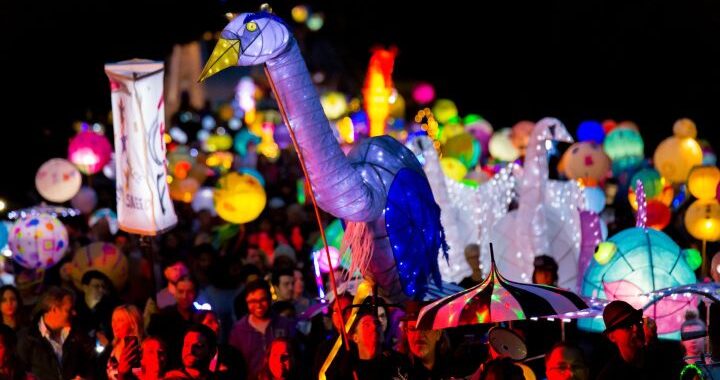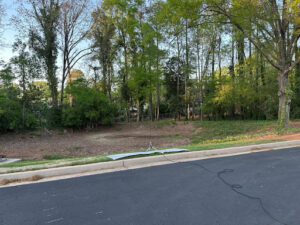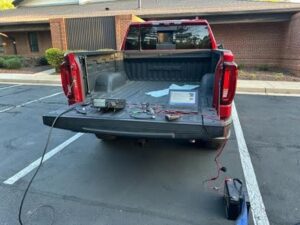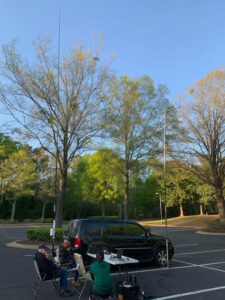This past Tuesday (April 8, 2025), the North Fulton ARES held its monthly meeting. The venue was a bit different this time. Instead of the traditional seated meeting, it was held outdoors to observe a couple of stations setting up to transmit data to a simulated served agency that had been collected the previous weekend. The ARES team had supported the annual Sandy Springs Lantern Parade several days earlier. As in past years, ARES was instrumental in providing communication support to Sandy Springs Fire Corps and reducing the need for 911 calls related to minor issues. NF ARES thanks NFARL for the use of the Morgan Falls repeater (145.47 MHz). It provides reliable communications for the Lantern Parade volunteers.
Fig 1 Sandy Springs 2025 Annual Lantern Parade.
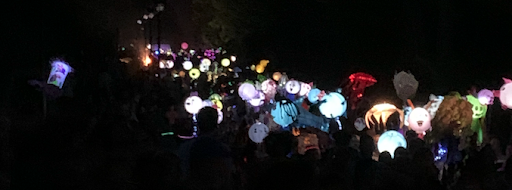
An ‘Event Log’ was used to record volunteer participation and document communication exchanges during the parade (Fig 2). The event log was created by W4IU with feedback from AD4MC to capture 1) participants and 2) information that is included in ICS reporting forms for emergencies. A key feature aimed to maximize data collection with a minimal number of keystrokes while automatically annotating a timestamp for each logged entry. Abby (KQ4JEU), in the role of ANCS, effectively utilized the Event Log during the Lantern Parade, validating its usability.
Fig 2. Simulated event log
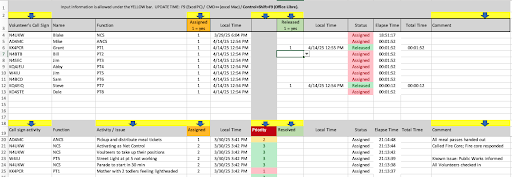
After the parade concluded, the raw data was extracted from the spreadsheet and saved in CSV format. Using a CSV format reduced the original document's size from 37 to 3 kilobytes. Mike, AD4MC, conducted speed comparison tests using FLDIGI and Winlink (Vara HF). Mike’s initial test using the MT_63_2KL format (FLDIGI) through the local repeater took just under 2:30 minutes. The second message was sent to W4IU’s email address via Vara HF 20 meters through the RMS station N5TW in Texas; it took just under a minute to complete.
The final part of the test involved sending a message back to Mike using Vara HF, this time in the peer-to-peer (P2P) format. In other words, the message is intended for only one station. The exercise also provided an opportunity for ARES members to observe and experience the setup of a remote station composed of HF and VHF components. The ‘remote’ stations were Bill (N4BTB) and Jim (W4IU). Both N4BTB and W4IU successfully set up remote HF stations relatively quickly (see Fig 3). Robert (AJ4RJ), our Emergency Coordinator, documented the meeting on Zoom using his phone. It was as if we had our own news reporter on-site.
The three stations utilized HF radio to transmit Vara HF P2P messages, while the VHF FM phone component facilitated coordination among them. Mike's HF station used a G5RV antenna, whereas the two ‘remote’ stations employed quick-setup vertical HF antennas. For 2-meter communications, only the 3-element (horizontally polarized) antenna mounted on a 20-foot push-up mast, running at 50 watts, could establish communication between AD4MC and the ‘remote’ locations. Curiously, the mobile stations operating at the same power levels could not bridge the 10-mile gap. The ‘remote’ stations were set up in the parking lot of the Latter-day Saints Worship Center located near downtown Roswell, north of Mike’s location. The topography at Mt. Vernon in Sandy Springs proved to be a challenge for line-of-sight communications between the ‘remote’ site and AD4MC’s location on the VHF/UHF bands.
The first two-way HF transmissions occurred between AD4MC and N4BTB, followed by a similar exchange between AD4MC and W4IU. The message content was the CSV file obtained from the Lantern Parade’s Event Log (Fig 4). Recall that Mike’s initial FLDIGI message using repeaters took nearly 2:30 minutes. Vara HF’s speed was impressive: sending the same file took roughly 20 seconds!
Fig 4. CSV file from the Lantern Parade Event Log (partial)
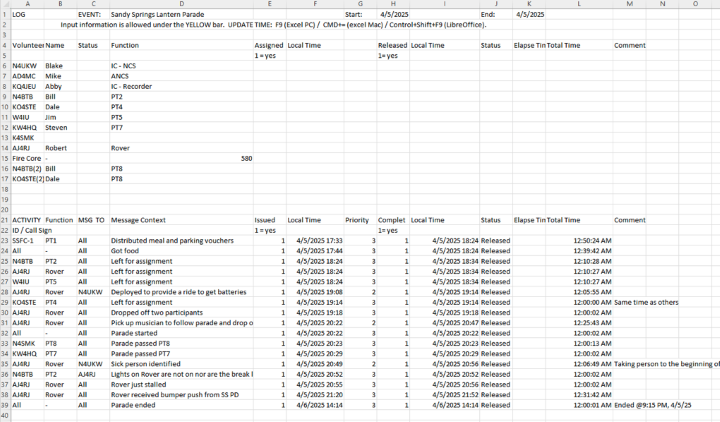
North Fulton ARES demonstrated our capacity to rapidly establish remote stations for transmitting dense messages locally or nationwide as required. This capability allows us to offer robust communication services to agencies requesting assistance. If you are interested in ARES activities, you can contact our EC, Robert (AJ4RJ), Mike (AD4MC), or Jim(W4IU).
73
Jim, W4IU
